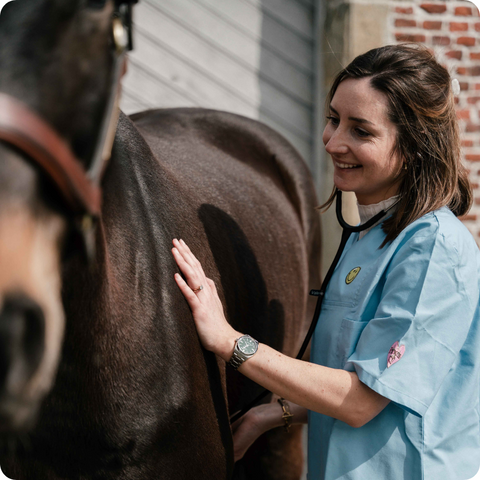Introduction
Osteoarthritis, also known as degenerative joint disease, is a common condition in horses that involves the gradual deterioration of cartilage within the joints. This can lead to pain, stiffness, and decreased mobility, significantly affecting a horse's performance and quality of life. Understanding the causes, recognizing the symptoms, and exploring available treatments are crucial steps in managing this chronic condition and ensuring the well-being of affected horses.
What is osteoarthritis in horses?
A joint is a place where two bones are joined together in the body in a way that enables them to bend and move. The ligaments and joint capsule give the two bones extra stability while cartilage covers and protects the bone ends. For your horse’s ease of movement, the joint space is filled with synovial fluid.
In sum, a joint is made up of different structures that are closely interlinked. If one part of the joint is out of sync, you soon end up with a domino effect impairing the functioning of the other parts.
Arthritis in horses is a general inflammation of the joint. If the cartilage around the joint is also damaged, the condition is classified as osteoarthrosis. In that case, the entire joint comes under pressure, causing pain and lameness.
Causes of osteoarthritis in horses?
While osteoarthritis in horses can have many causes, some horses and ponies are simply more prone to joint problems than others. Older horses, sport horses, horses that are overweight or had joint surgery before are particularly prone to this degenerative joint disease.
The condition of osteoarthritis has two main causes:
1. Abnormal pressure on normal cartilage
Your horse’s joint cartilage is perfectly healthy but is being damaged by excess pressure. Causes that spring to mind are intensive training, excessive strain, a fracture, abnormal posture…
2. Normal pressure on abnormal cartilage
The pressure on the joint isn’t abnormally high but the joint isn’t as healthy as it should be. That combination leads to further degeneration, like OCD for instance, a condition characterised by loose cartilage and/or bone fragments in the joint.
How to spot osteoarthritis in your horse?
1. Your horse has become less flexible
Osteoarthritis doesn’t usually start with obvious lameness but with a stiff and rigid gait. Your horse is slow to get going and seems less flexible when being ridden. In the case of osteoarthritis of the neck, he will find it difficult to stretch or flex his neck. Typical symptom of osteoarthritis: after a ten-minute warm-up your equine friend will gradually move less rigidly. Movement warms up the muscles, tendons and joints and soon gets him moving more freely.
2. Your horse has problems rolling and getting up
Is your horse rolling less frequently and is he struggling to get up? This can be caused by a lack of flexibility in his vertebral column, with osteoarthritis as the primary cause.
3. Your horse is acting up while being ridden
When making certain movements, like jumping and landing, your horse’s cartilage is put under great strain. Worn cartilage absorbs shocks less well and this can be extremely painful for your horse.
4. Your horse is lame
Osteoarthritis causes a stabbing pain when making certain movements. So, your horse can be pretty lame, which is especially noticeable when performing a volte and straight line. Another obvious sign of lameness: when your horse’s head nods with every move. This will be most obvious while trotting.
5. Your horse is irritable and moody
If your horse is in pain, he can be irritable and moody (face it, how would you be yourself?). He will be less tolerant of people and other horses, will pin his ears back, swish his tail and bite or kick.
6. Your horse has trouble chewing
If your equine friend drops food out of his mouth, chews at a slant or on one side only, his jaw joint is probably sore - with osteoarthritis at the root. Mind: these signs can also be a symptom of general dental problems. Do the above symptoms sound familiar? In that case, your horse is more than likely suffering from osteoarthritis. Unfortunately, there is no cure but luckily it can be treated. What’s more, the sooner you take action, the better you will be able to help your horse. Time for a visit to the vet in other words! We wish you every success!
How to treat your horse with osteoarthritis?
1. "Establish the correct diagnosis in case of doubt about osteoarthritis."
Do you suspect that your horse might be suffering from osteoarthritis? Don’t go it alone but contact your vet and have your horse examined, just to make sure.
2. Treat the inflammation
It is essential to get the pain and the inflammation of the joint under control as quickly as possible to prevent further damage to the cartilage. The vet will inject anti-inflammatories in the joint or put him on an anti-inflammatory diet.
3. Ensure your horse gets exercise
Exercise is the one way to lubricate your horse’s joints! Start with daily hand-walks and build up gradually. Don’t even think about riding him until your vet and your horse give you the go-ahead.In some horses, the osteoarthritis is so far advanced that riding them is no longer an option.
4. Organise physiotherapy and osteopathy
These therapies not only help to keep your horse’s muscles and ligaments flexible but will also alleviate the pain
5. Maintain a healthy body weight
Horses that are overweight put excessive strain on their joints. Ensure a diet that suits your horse to prevent osteoarthritis.
6. Look after your horse’s hooves
Properly trimmed hooves are instrumental in ensuring that the load on the joints is evenly distributed to prevent osteoarthritis.
7. Provide a peaceful environment
It is important to let your horse choose when he wants to go for a walk. So, regularly let him out into the paddock. Choose a peaceful environment where he is not being chased by other horses.




